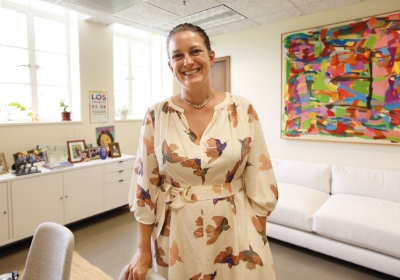“I ONCE CAUGHT THIS GUY VANDALIZING A BUS and he called me a Keystone Cop,” said the petite, red-headed woman across the table from me. “‘Well, then,’ I told him. ‘I guess I’ll arrest you with these fake handcuffs and take you to a fake jail.’”
I am at an Italian restaurant in Palos Verdes having lunch with Sharon Papa, Metro’s former chief of police, discussing the transportation agency’s fateful 1996 decision to merge its in-house transit police force with the Los Angeles Police Department and Los Angeles Sheriff’s Department. At its height, the MTA police force had more than 500 officers, was the 10th-largest police force in California and the largest transit police force in the nation. But it fell to a combination of money, power struggles and L.A. politics.
Papa was at the center of that. “I won the battle, but I lost the war,” she said, and took a sip of iced tea.
Here in Palos Verdes, the day was breezy and cloudless, just like the days before and after. But back at Metro headquarters in downtown Los Angeles, more change was brewing.
After nearly 27 years of contracting out policing (currently, law enforcement is handled by the LAPD, LASD, and the Long Beach Police Department), the Metro Board of Directors voted to change course once again and form its own public safety department. The idea wasn’t out of left field — plenty of transit agencies have them (the Bay Area’s BART, Massachusetts’ MBTA and Atlanta’s MARTA, to name a few). And the idea had been the subject of numerous committee meetings and feasibility studies. For Papa, this was familiar ground.
There are many advantages to bringing policing in-house, Papa explained. You can control costs, hire and train personnel, and create your own policies and procedures. You can address new issues as they come up without waiting for the go-ahead. You can tailor your police force to a transit environment, which is somewhat unique, since it traverses multiple cities and jurisdictions.
Moreover, transit policing combines unusual elements: Buses and rail cars create close quarters, but they also are public spaces, and in motion much of the time. They’re used by all kinds of people traveling far from their homes. All of that makes it difficult to extend the policing practices of other agencies to the specific challenges of patrolling transit systems.
The timing also felt right for a new approach. A series of high-profile violent crimes on the Metro system had shaken the public’s trust in transit. Assaults against bus operators had hit all-time highs (Metro recorded 168 in 2023). And, crucially, the cost of existing policing contracts with the LAPD, LASD and LBPD had been rising precipitously (the FY24 contracts came to $194 million, a cost increase of 15% over the previous year).
The contract model came with other drawbacks, too: inconsistent enforcement, lack of oversight, data and reporting delays. Then there were jurisdictional issues. Who would be responsible for apprehending a bus traveling down Wilshire Boulevard, for example, moving from the city of Los Angeles to Beverly Hills to Santa Monica? This problem, Papa pointed out, had been one of the reasons why her transit police force had been created during the 1970s. “Unless the bus stopped and waited for [the police],” she recalled, “officers didn’t ‘chase’ the bus.”
One year after approving a plan to explore creating a new public safety department, the Metro Board of Directors voted to make it official, authorizing a five-year plan to implement an in-house police force. Many staff members celebrated, relieved that weeks of long nights had paid off.
But change will not be easy. Police agencies across the country are struggling with recruitment. Transit police are sometimes seen as less glamorous than municipal forces or sheriff’s agencies, which may make hiring even more difficult. Papa also foresees future political battles not unlike the ones she experienced, such as turf wars with other agencies.
“You need someone who isn’t afraid to fight,” she said. “You need to be a tough cookie.”
Metro faces different issues than it did decades ago. In 1997, there wasn’t even a system for counting homeless in LA County. In 2023, there were 75,518. In 1997, hardly anyone had heard of fentanyl. Today, Los Angeles is facing the largest opioid epidemic it has ever faced in its history. In 1997, Metro only had three rail lines that covered 46.3 miles. Today, it has six rail lines that cover 109 miles, and many more on the horizon. All of those factors complicate policing on the region’s transit systems.
Still, the decision feels a bit like a new beginning — or a return to an old one. History has a way of repeating itself.























